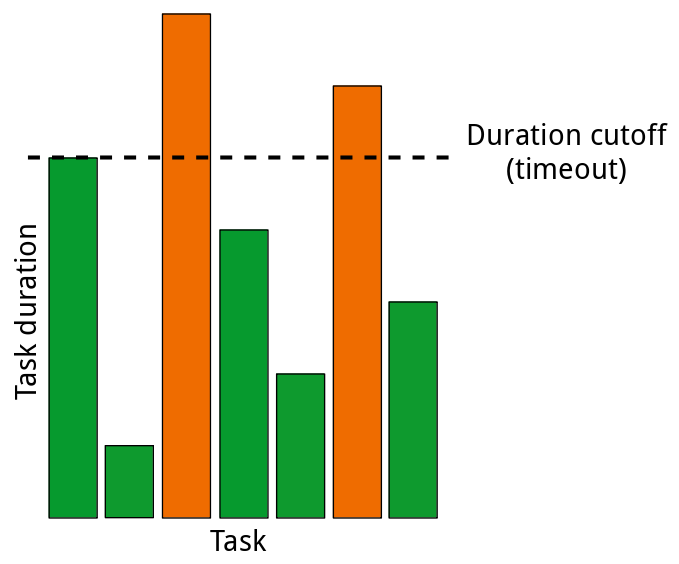The problem
Sometimes you may want to impose a timeout on a Python function. Why would you want to do such a thing? Let’s say you’re computing something but you know there are some hopeless scenarios where the computation just takes too long, and you’d be OK to just skip them and go on with the rest of the workflow.
For an illustration, the figure below shows several tasks. Those that take longer than the specified timeout should be aborted (orange) and the remaining tasks that take a reasonable amount of time should be executed normally (green).

There are several ways in which setting a timeout on a function may be achieved such that the execution continues past the timed-out method. We will be examining two solutions here:
- in the previous post we have used the
signalmodule; - in this post we will be using the
multiprocessingmodule.
Solution using the multiprocessing module
Just like in the previous post, suppose we have a method that can be very time-consuming:
1
2
3
4
5
import time
def do_stuff(n):
time.sleep(n)
print('slept for {}s'.format(n))
For the purpose of this example, we want to let this function do_stuff() run until it either completes or hits the 5-second mark, whichever event comes first. Actually, in the previous post, we let it run just below 6 seconds, because the argument to signal.alarm() is necessarily an integer. If that argument was 5, do_stuff() would not have been allowed to run for 5 seconds. Apart from the shortcomings of the signal-based solution, the multiprocessing module also solves this nagging issue; we can now use a non-integer timeout, for example 5.01 seconds.
Although multiprocessing is the package that comes to mind when attempting to parallelize processes, its basic role is to simply spawn processes, as its name implies. (Processes spawned with multiprocessing may, but do not have to, be parallel.) We can set a timeout on the processes that are spawned, which is exactly what we are looking for here.
The script below runs indefinitely. At each passage through the infinite loop, it randomly selects a duration between 1 and 10 seconds. It then spawns a new multiprocessing.Process that executes the time-consuming do_stuff() function for the random duration. If do_stuff() doesn’t finish in 5 seconds (actually, 5.01 seconds), the process terminates:
1
2
3
4
5
6
7
8
9
10
11
12
13
14
15
16
17
18
19
20
21
22
23
24
25
26
27
28
29
import multiprocessing as mp
import random
import time
def do_stuff(n):
time.sleep(n)
print('slept for {}s'.format(n))
def main():
max_duration = 5
while True:
duration = random.choice([x for x in range(1, 11)])
print('duration = {}: '.format(duration), end='', flush=True)
process = mp.Process(target=do_stuff, args=(duration,))
process.start()
process.join(timeout=max_duration + 0.01)
if process.is_alive():
process.terminate()
process.join()
print('took too long')
if __name__ == '__main__':
main()
A multiprocessing.Process is spawned at line 18 with do_stuff() as its target and the random duration as argument for do_stuff(). Next, we start the process at line 19, and then we “join” it (meaning we wait for it to finish) at line 20, but with a twist: it is here that we actually specify the timeout. In other words, we wait for it to finish for the specified timeout. In lines 22-25 we check whether the process actually finished, in which case is_alive() returns false. If it is still running, we terminate the process and display a message on STDOUT.
Here is the output of this script:
1
2
3
4
5
6
7
8
9
duration = 7: took too long
duration = 9: took too long
duration = 2: slept for 2s
duration = 5: slept for 5s
duration = 2: slept for 2s
duration = 6: took too long
duration = 5: slept for 5s
duration = 3: slept for 3s
duration = 7: ^C
Notes
- Simply spawning processes with the
multiprocessingmodule does not mean we have parallelism. In order to do this we’d need to add tasks to amultiprocessing.Pool. This article or this one show examples of pools. - Care must be taken when using
terminate()to stop a process. Here is what the Python documentation has to say about it:Warning: If this method is used when the associated process is using a pipe or queue then the pipe or queue is liable to become corrupted and may become unusable by other process [sic]. Similarly, if the process has acquired a lock or semaphore etc. then terminating it is liable to cause other processes to deadlock.
Conclusion
In this post we’ve seen another solution for setting a timeout on a function in Python, this time using the multiprocessing module. It is easy to implement and does not suffer from any of the drawbacks of the signal-based solution described in the previous post.
Further reading
multiprocessing(Python documentation)- Parallel processing in Python (Frank Hofmann on stackabuse)
multiprocessing– Manage processes like threads (Doug Hellmann on Python Module of the Week)
Comments powered by Disqus.